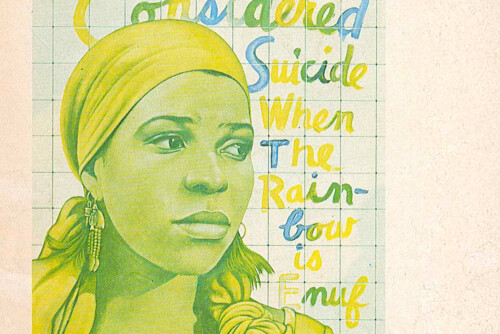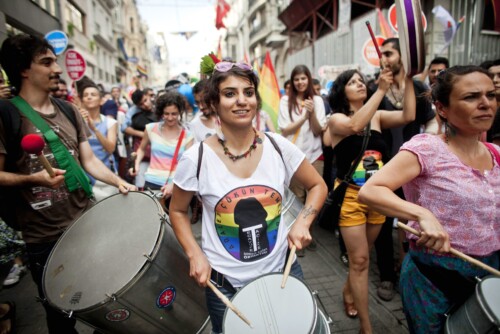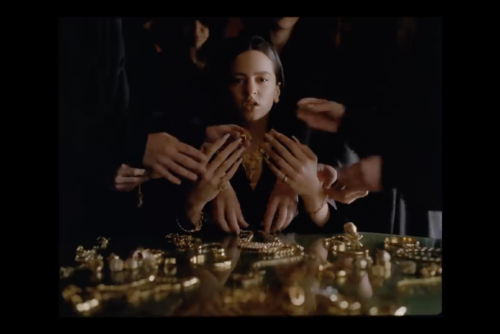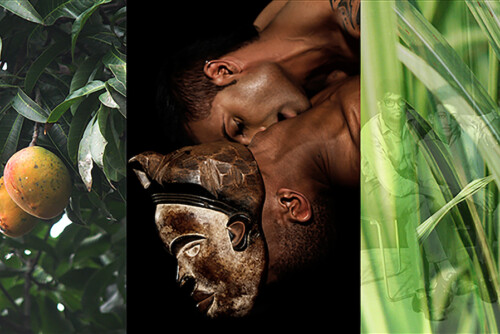“I use poetry the way some people use encyclopedias: to find out more. I listen for a voice that springs from a real breath, a sweating body that speaks, or I stop reading.”
—Ntozake Shange, interviewed in “Rescuing the Canon” in June Jordan’s Poetry for the People: A Revolutionary Blueprint (New York: Routledge, 1995).
Works by Ntozake Shange
Books
Betsey Brown. New York, New York: St. Martin’s Press, 1985.
Coretta Scott. New York, New York: Katherine Tegen Books, 2009.
Daddy Says. New York, New York: Simon & Schuster Books for Young Readers, 2003.
A Daughter’s Geography. New York, New York: St. Martin’s Press, 1983.
Ellington Was Not a Street. New York, New York: Simon & Schuster Books for Young Readers, 2004.
for colored girls who have considered suicide / when the rainbow is enuf. San Lorenzo, California: Shameless Hussy Press, 1975.
Freedom’s A-Calling Me. New York, New York: Amistad, 2012.
From Okra to Greens: Poems. St. Paul, Minnesota: Coffee House Press, 1984.
I Live in Music: Poem. New York, New York: Welcome Books, 1994.
If I can cook/you know God can. Boston, Massachusetts: Beacon Press, 1998.
Liliane: Resurrection of the Daughter. New York, New York: Picador USA, 1995.
lost in language & sound: or how I found my way to the arts. New York, New York: St. Martin’s Press, 2011.
The Love Space Demands: A Continuing Saga. New York, New York: St. Martin’s Press, 1991.
Melissa & Smith. St. Paul, Minnesota: Bookslinger Editions, 1976.
Muhammad Ali, the Man Who Could Float like a Butterfly and Sting like a Bee. 1st ed. New York, New York: Jump at the Sun/Hyperion Books for Children, 2002.
Nappy Edges. New York, New York: St. Martin’s Press, 1978.
A Photograph: Lovers in Motion. New York, New York: French, 1981.
Ridin’ the Moon in Texas: Word Paintings. 1st ed. New York, New York: St. Martin’s Press, 1987.
Sassafrass. San Lorenzo, California: Shameless Hussy Press, 1976.
Sassafrass, Cypress & Indigo. 1st ed. New York, New York: St. Martin’s Press, 1982.
See No Evil: Prefaces, Reviews & Essays, 1974-1983. San Francisco, California: Momo’s Press, 1984.
Some Sing, Some Cry. 1st ed. New York, New York: St. Martin’s Press, 2010.
The Sweet Breath of Life: A Poetic Narrative of the African-American Family. New York, New York: Atria Books, 2004.
Three Pieces. 1st ed. New York, New York: St. Martin’s Press, 1981.
We Troubled the Waters. New York, New York: Amistad, 2009.
Whitewash. New York, New York: Walker & Co., 1997.
Work Published in Journals and Magazines
“5.” Black Renaissance 6.2 (2005): 125.
“Black and White Two-Dimensional Planes.” Callaloo 5 (February 1979): 56-62.
“Christmas for Sassafrass, Cypress & Indigo.” Essence 13:8 (1982): 68.
“For Any Other Child First/second in a Devil’s School Especially, Chirren in Brooklyn/queens ’72.” The American Poetry Review 4.3 (1975): 40.
“Get It & Feel Good.” Essence 9 (1979): 88.
“Is Not so Gd to Be Born a Girl (1).” Black Scholar 10.8/9 (1979): 28–29.
“It’s Not so Good to Be Born a Girl/Sometimes.” Heresies: a feminist publication on art & politics 6.3 (1988): 53.
“Letter to a Young Poet.” Ms. (Fall 2011): 50–53.
“Lizard Series 1.” The Antioch Review 59.4 (Autumn 2001): 744-747.
“Lizard Series II.” Black Renaissance 6.2 (2005): 123.
“Monster’s Ball.” Vibe 10.10 (2002): 84.
“Moon Indigo.” Essence (Mar. 1996): 136.
“Moon Journey.” Heresies: a feminist publication on art & politics 4.2 (1982): 35.
“oh she gotta head fulla hair.” Black Scholar 10. 3/4 (November/December 1978): 13-14.
“Otherwise I Would Think It Odd to Have Rape Prevention Month (2).” Black Scholar 10.8/9 (1979): 29–30.
“Pages for a Friend.” Ms. (Jan. 1995): 33.
“Pornography: Where Do We Stand?” (with Andrea Dworkin, Barbara Findlen, Marilyn French, Marcia Ann Gillespie, Gloria Jacobs, and Norma Ramos). Ms. 4.4 (1994): 32–41.
“three (for international women’s day).” Black Scholar 6.9 (June 1975): 56-61.
“Unrecovered Losses/Black Theatre Traditions.” Black Scholar 10.10 (1979): 7–9.
“‘We Are Not Part of Cane Fields.’” Modern Maturity 39 (1996): 46.
“Why I Had To DANCE.” Black Renaissance 6/7.3/1 (2006): 40–42, 171.
“With No Immediate Cause.” Heresies: a feminist publication on art & politics 2.2 (1978): 12.
“Wow . . . Yr Just like a Man!” Ms. 7 (1978): 50.
Sound Recordings featuring Ntozake Shange
Black Box 13/14. Vol. 1–2. Washington, D.C.: Watershed Foundation, 1978. Cassette tape. 2 vols.
I Live in Music. Washington, D.C.: Watershed Foundation, 1984. Cassette tape.
Ntozake Shange & Carolyn Forche. New York, New York: Academy of American Poets, 1978. cassette tape.
Ntozake Shange and David Murray. Wild Flowers. CD Baby, 2006. Audio CD.
Sound Recordings for which Ntozake Shange wrote liner notes
Billy Bang Quartet. Bang on! Montréal: Justin Time, 1997. compact disc.
Dara, Olu. In the World from Natchez to New York. New York, New York: Atlantic, 1998. compact disc.
Simone, Nina. A Single Woman. New York, New York: Elektra Entertainment, 1993. compact disc.
Primary Sources
Barnard College Archives
The materials cited below are housed at the Barnard College Archives. For more information on viewing these sources, contact College Archivist Shannon O’Neill at soneill@barnard.edu or Digital Archivist Martha Tenney at mtenney@barnard.edu.
Ntozake Shange. BC 8.4. Alumnae Biographical Files. Box 10 contains press clippings, images, flyers, and photocopied biographical articles on Ntozake Shange.
Reid Lectureship: Ntozake Shange. 1978. BC 13.56. Barnard Center for Research on Women. Box 30. Folder 6 includes materials documenting Ntozake Shange’s guest lectureship at Barnard College in November 1978. Materials include correspondence, brochures, and press clippings.
Columbia Rare Books and Manuscripts Library
These editions of for colored girls are housed in the Rare Books and Manuscripts Library, in Columbia University’s Butler Library. For more information on viewing these sources, contact Curator for Literature Karla Nielsen at kn2300@columbia.edu.
Shange, Ntozake. Holup, Wopo (illustrator). for colored girls who have considered suicide / when the rainbow is enuf. San Lorenzo, California: Shameless Hussy Press, 1975.
Shange, Ntozake. for colored girls who have considered suicide / when the rainbow is enuf: a choreopoem. New York, New York: MacMillan, 1977.
Correspondence
Annette Kar Baxter Papers. Sophia Smith Collection, Smith College. Northampton, MA. Includes correspondence between Annette Kar Baxter and Ntozake Shange. (link to finding aid)
June Jordan Papers. Schlesinger Library, Radcliffe Institute, Harvard University. Cambridge, MA. Includes correspondence between June Jordan and Ntozake Shange. (link to finding aid)
Michele Wallace Papers Contain meeting minutes, proposals, and correspondence for The Sisterhood, a black women writers’ group which featured among its members Ntozake Shange, Margo Jefferson, Audre Lorde, Alice Walker, and Michele Wallace. Schomburg Research Collections. Manuscripts, Archives, and Rare Books Division. (link to catalog record)
Shameless Hussy Press Records, 1968-1989. Special Collections. University of California, Santa Cruz. Santa Cruz, CA. Includes correspondence with Ntozake Shange, 1975-1982. (link to finding aid)
Manuscripts
Betsko-Koenig Women Playwrights Collection, 1955-1990. Sophia Smith Collection, Smith College, Northampton, MA. Scripts of Betsey Brown (the opera and the novel), for colored girls who have considered suicide/when the rainbow is enuf, and Three Pieces.
Circle Repertory Company Records, 1965-1996. Billy Rose Theatre Division, New York Public Library for the Performing Arts. Script and evaluation of Shange’s I Heard Eric Dolphy In His Eyes in Series III: Unproduced Scripts, 1931-1994 (Box 266, Folder 7).
Momo’s Press Records, 1972-1986. Bancroft Library. University of California, Berkeley. Berkeley, CA. Includes unpublished manuscripts, contracts and permissions, galleys, and other material related to See No Evil (1984).
Shameless Hussy Press Records, 1968-1989. Special Collections. University of California, Santa Cruz. Santa Cruz, CA. Includes typescripts with corrections and layout maquettes, as well as multiple printings, of for colored girls who have considered suicide/ when the rainbow is enuf (1975-1976) and Sassafrass (1974-1978).
Production Histories
The New York Public Library for the Performing Arts holds numerous materials of interest to researchers exploring Ntozake’s work as a choreographer, writer, director, and performer. The list below presents a few highlights of these collections. To explore these collections further, consult the NYPL site.
Ntozake Shange. One Hollinger Box of clippings, reviews, press releases, and other materials on Ntozake Shange, covering the years 1976-2007. Performing Arts Research Collections: Billy Rose Theatre Division.
Oral History Interview with Ntozake Shange by Kenneth Turan (1987). One sound disc, transferred from analog sound cassette. Performing Arts Research Collections: Sound.
Showtapes, readings, outtakes, cues, worktapes, rehearsals, and studio vocals from productions of works including for colored girls, Spell #7, A Photograph: Lovers in Motion, and Betsey Brown.
Images
Barboza, Anthony. Ntozake Shange. 1977. Gelatin silver print. Smithsonian Institution. Via Digital Public Library of America.
Ntozake Shange Portrait Collection. Schomburg Center for Research in Black Culture, New York Public Library. Features seven quarter-length black-and-white photographic prints of Ntozake Shange, taken in the 1970’s and 1980’s by Frank Stewart, among others. (link to catalog record)
Ntozake Shange standing in front of a table of unidentified students with a paper in her hand. Black-and-white photograph. Special Collections, University of Houston Libraries. University of Houston Digital Library.
Swope, Martha. Playwright Ntozake Shange in Publicity Shot for the New York Shakespeare Festival Production of Her Play Spell #7. Color photograph. 1979. Via New York Public Library Digital Collections.
Swope, Martha. Playwright Ntozake Shange with Cast Members in Publicity Shot for the New York Shakespeare Festival Production of Her Play Spell #7. Color photograph. 1979. New York Public Library Digital Collections.
Unknown artist. Scanned image of cover of Italian translation of for colored girls: Per ragazze di colore che hanno pensato al suicidio quando l’arcobaleno basta, translated by Simonetta Franceschetti. 1997. Link via Europeana.
Unknown photographer. Ntozake Shange, Barnard College, Reid Lecture, Women Issues Luncheon, Women’s Center, November 1978. Black-and-white photograph. Barnard College Archives. Via Wikimedia Commons.
Performances
For Colored Girls Who Have Considered Suicide/ When The Rainbow Is Enuf. Dir. Oz Scott, Perf. Alfre Woodard, Lynn Whitfield, Ntozake Shange. Thirteen/WNET New York, American Playhouse, 1982.
Recordings
Grace Cavalieri Papers, 1945-2014. Special Collections Research Center, George Washington University. Washington D.C. Includes a magnetic audiotape reel of “Poetry from the City: Folger Shakespeare Library; Thulani Davis and Ntozake Shange.”
Critical Studies of Ntozake Shange’s Work
Articles
Abdel–Shehid, Gamal. “Cultural Globalization and the Soul Food Memoir: Austin Clarke, Ntozake Shange and Marlon Riggs.” Journal of Historical Sociology 15.4 (2002): 451–463.
Brown, E. Barnsley. “‘The Human Body in Motion’: Writing the Body/Righting History in the Plays of Ntozake Shange.” Obsidian III 1 (1999): 212–38.
Clark, Patricia E. “Archiving Epistemologies and the Narrativity of Recipes in Ntozake Shange’s ‘Sassafrass, Cypress & Indigo.’” Callaloo 30.1 (2007): 150–162.
Cronacher, Karen. “Unmasking the Minstrel Mask’s Black Magic in Ntozake Shange’s ‘Spell #7.’” Theatre Journal 44.2 (1992): 177–193.
Elder, Arlene. “Sassafrass, Cypress & Indigo: Ntozake Shange’s Neo-Slave/Blues Narrative.” African American Review 26.1 (1992): 99–107.
El-Shayal, Dalia. “Nonverbal Theatrical Elements in Ntozake Shange’s ‘for Colored Girls…’ and Intissar Abdel-Fatah’s ‘Makhadet El-Kohl’ (The Kohl Pillow).” Comparative Drama 37.3/4 (2003): 361–378.
Fabre, Geneviève. “Ntozake Shange.” Revue française d’études américaines 10 (1980): 259–270.
Flowers, Sandra Hollin. “Colored Girls: Textbook for the Eighties.” Black American Literature Forum 15.2 (1981): 51–54.
Frank, Rebecca Morgan. “Commentary: A Collective Appetite: Reception and the White Gaze from Shange to Sapphire.” Black Camera 4.1 (2012): 215–219.
Hammad, Lamia Khalil. “Black Feminist Discourse of Power in For Colored Girls Who Have Considered Suicide.” Rupkatha Journal on Interdisciplinary Studies in Humanities 3.2 (2011): 259-267.
Helen, Melissa. “Empowering Oneself to Break Free from a European Psychology and Framework: A Study of Ntozake Shange’s Choreopoem, for Colored Girls Who Have Considered Suicide When the Rainbow is Enuf.” The IUP Journal of American Literature 3.1 (2010): 13-25.
Kamini, R. “Shange’s Choreopoem: Polyphony in Dramatic form in ‘for colored girls’ and ‘spell# 7’.” Journal of Literature, Culture and Media Studies 2.4 (2011).
Louis, Diana Martha. “Bitch You Must Be Crazy: Representations of Mental Illness in Ntozake Shange’s for Colored Girls Who Consider Suicide When the Rainbow Is Enuf (1976).” Western Journal of Black Studies 37.3 (2013): 197–211.
Mafe, Diana Adesola. “Black Women on Broadway: The Duality of Lorraine Hansberry’s A Raisin in the Sun and Ntozake Shange’s for Colored Girls.” American Drama 15.2 (2006): 30–47, 91.
Mahurin, Sarah. “‘Speakin Arms’ and Dancing Bodies in Ntozake Shange.” African American Review 46.2 (2013): 329–343.
Renuga, P. “A saga of struggle to survive and surface-a study of Ntozake Shange’s for colored girls who have considered suicide/when the rainbow is enuf.” Zenith International Journal of Multidisciplinary Research 4.3 (2014): 145-148.
Reyes, Júlia, and Adelaine LaGuardia. “Sing a Black Girl’s Song: Ntozake Shange e o Feminismo Afro-Americano.” Cadernos do IL 0.47 (2013): 4–20. (open link to article)
Richards, Sandra L. “Conflicting Impulses in the Plays of Ntozake Shange.” Black American Literature Forum 17.2 (1983): 73–78.
Splawn, Jane. “New World Consciousness in the Poetry of Ntozake Shange and June Jordan: Two African American Women’s Response to Expansionism in the Third World.” CLA Journal 39.4 (1996): 417-431.
Spyra, Ania. “Ntozake Shange’s Multilingual Poetics of Relation.” Contemporary Literature 54.4 (2013): 785–809.
Thompson-Cager, Chezia. “Ntozake Shange’s ‘Sassafrass, Cypress and Indigo’: Resistance and Mystical Women of Power.” NWSA Journal 1.4 (1989): 589–601.
Timpane, John. “’The Poetry of a Moment’: Politics and the Open Form in the Drama of Ntozake Shange.” Modern American Drama: The Female Canon (1990): 198–206.
Tucker, Christopher. “‘I Will Pay That Price as a Poet to Speak My Truth’: Feminism, Activism, and the Historical Moment of Ntozake Shange’s For Colored Girls.” Moravian Journal of Literature & Film 4.1 (2013).
Valdés, Vanessa K. “‘There Is No Incongruence Here’: Hispanic Notes in the Works of Ntozake Shange.” CLA Journal 53.2 (2009).
Wardi, Anissa Janine. “The Cartography of Memory: An Ecocritical Reading of Ntozake Shange’s Sassafrass, Cypress & Indigo.” African American Review 45.1/2 (2012): 131–142, 273.
Waxman, Barbara Frey. “Dancing out of Form, Dancing into Self: Genre and Metaphor in Marshall, Shange, and Walker.” MELUS 19.3 (1994): 91–106.
West, Amber. “Metamorphic Rainbows: The Journey of Shange’s for colored girls From Poetry to Television and Beyond.” Journal of Research on Women and Gender 1 (2010): 191-208.
William-White, Lisa et al. “Arugula, Pine Nuts, and Hegemony: Seven Women’s Choreopoetic Reflection on the Absence of Cultural Relevance in Educational Discourse.” International Journal of Qualitative Studies in Education 25.2 (2012): 135–149.
Books and Book Chapters
Allen, Carol. “Dipped in the Pool: Shange’s Choreopoems as Atlantic Crossings.” Peculiar Passage: Black Women Playwrights, 1875 to 2000. New York, New York: Peter Lang, 2005.
Cataliotti, Robert H. “‘A way of life’: Coming-of-Age through Music in Al Young’s Snakes & Ntozake Shange’s Betsey Brown.” The Songs Became the Stories: The Music in African American Fiction, 1970-2005. New York, New York: Peter Lang, 2007.
Clarke, Cheryl. “Black Feminist Communalism: Ntozake Shange’s for colored girls who have considered suicide/when the rainbow is enuf.” “After Mecca”: Women Poets and the Black Arts Movement. New Brunswick, New Jersey: Rutgers University Press, 2005.
Geis, Deborah. “Distraught Laughter: Monologue in Ntozake Shange’s Theater Pieces.” Feminine Focus: The New Women Playwrights. Ed. Enoch Brater. New York, New York: Oxford University Press, 1989.
Lester, Neal A. Ntozake Shange: A Critical Study of the Plays. New York, New York: Garland Pub, 1995.
“Ntozake Shange.” Historical Dictionary of African American Theatre. Anthony D. Hill and Douglas Q. Barnett eds. Lanham, Maryland: Scarecrow Press, 2009.
Olaniyan, Tejumola. “Ntozake Shange: The Vengeance of Difference, or The Gender of Black Cultural Identity.” Scars of Conquest/Masks of Resistance: The Invention of Cultural Identities in African, African-American, and Caribbean Drama. New York, New York: Oxford University Press, 1995.
Thorsson, Courtney. “Cooking Up a Nation: Ntozake Shange’s Sassafrass, Cypress, and Indigo.” Women’s Work: Nationalism and Contemporary African American Women’s Novels. Charlottesville, Virginia: University of Virginia Press, 2013.
Wardi, Anissa Janine. “Shange’s Sassafrass, Cypress and Indigo and Julie Dash’s Daughters of the Dust.” Water and African American Memory: An Ecocritical Perspective. Gainesville, Florida: University Press of Florida, 2011.
Washington, Teresa N. “Initiations into the Self, the Conjured Space of Creation, and Prophetic Utterance in Ama Ata Aidoo’s Anowa and Ntozake Shange’s Sassafrass, Cypress & Indigo.” Our Mothers, Our Powers, Our Texts: Manifestations of Ajé in Africana Literature. Bloomington, Indiana: Indiana University Press, 2005.
Young, Jean. “Ritual Poetics and Rites of Passage in Ntozake Shange’s for colored girls who have considered suicide/ when the rainbow is enuf.” Black Theatre: Ritual Performance in the African Diaspora. Ed. Paul Carter Harrison and Gus Edwards. Philadelphia, Pennsylvania: Temple University Press, 2002.
Historical and Biographical Context
Als, Hilton. “Color Vision.” New Yorker 86.35 (2010): 42–47.
Balance, Christine Bacareza. “Dancing to Rock & Roll Poetry: Jessica Hagedorn and the West Coast Gangster Choir.” Boom: A Journal of California 3.2 (2013): 72–81.
Barrios, Olga. “From Seeking One’s Voice to Uttering the Scream: The Pioneering Journey of African American Women Playwrights through the 1960s and 1970s.” African American Review 37.4 (2003): 611–628.
Bayeza, Ifa. “Zake and Me and ‘for colored girls.’” American Theatre 27.10 (2010): 42–45.
Burke, Sally. “The Second Wave: A Multiplicity of Concerns.” American Feminist Playwrights: A Critical History. New York, New York: Twayne, 1996.
Collins, Lisa Gail. “Activists Who Yearn for Art That Transforms: Parallels in the Black Arts and Feminist Art Movements in the United States.” Signs 31.3 (2006): 717–752.
Dickerson, Glenda. “The Cult of True Womanhood: Toward a Womanist Attitude in African-American Theatre.” Theatre Journal (May, 1988): 178-187.
Gumbs, Alexis Pauline. “‘This Instant and This Triumph’: Women of Color Publishing.” American Book Review 29.4 (2008): 4–5.
Jordan, June. “Introduction.” The American Poetry Review 4.3 (1975): 40. (Note: June Jordan writes a poetic introduction to an early appearance of Shange’s verse in this journal.)
Mullen, Harryette Romell. “Artistic Expression was Flowing Everywhere’: Alison Mills and Ntozake Shange, Black Bohemian Feminists in the 1970s.” Meridians: feminism, race, transnationalism 4.2 (2004): 205–235.
“Ntozake Shange.” Historical Dictionary of African American Theatre. Anthony D. Hill and Douglas Q. Barnett eds. Lanham, Maryland: Scarecrow Press, 2009.
Reti, Irene and Jarrell, Randall, eds. Alta and the History of Shameless Hussy Press, 1969-1989. Santa Cruz, California: University of California, Santa Cruz, University Library, 2001.
Shockley, Evie. Renegade Poetics: Black Aesthetics and Formal Innovation in African-American Poetics. Iowa City, Iowa: University of Iowa Press, 2011.
Williams, Dana A. Contemporary African American Women Playwrights: An Annotated Bibliography. Westport, Connecticut: Greenwood Press, 1998.
Young, Patricia A. African American Women Playwrights Confront Violence. Jefferson, North Carolina: McFarland, 2012.
Interviews
Anderlini, Serina. “Drama or Performance Art? An Interview with Ntozake Shange.” Journal of Dramatic Theory and Criticism (Fall, 1991): 85-97.
Blackwell, Henry. “An Interview with Ntozake Shange.” Black American Literature Forum 13.4 (1979): 134–138.
Lester, Neal A. “At the Heart of Shange’s Feminism: An Interview.” Black American Literature Forum 24.4 (1990): 717–730.
Lyons, Brenda, and Ntozake Shange. “Interview with Ntozake Shange.” The Massachusetts Review 28.4 (1987): 687–696.
Lee, Felicia R. “Ntozake Shange Has a New Work and a Reprise.” The New York Times 17 Sept. 2010.
Pate, Alexs. “A Conversation with Ntozake Shange.” Black Renaissance 10.2/3 (2010): 78–85, 151.
Power, Will. “Catching Up With Ntozake Shange.” American Theatre 24.4 (2007): 30.
Ross, Marlon B., and Ntozake Shange. “An Interview with Ntozake Shange.” Callaloo 37.3 (2014): 486–490.
Shange, Ntozake. “Ntozake Shange Interviews Herself.” Ms. 6 (1977): 35.
Tate, Claudia. “Ntozake Shange” (interview). Black Women Writers at Work. New York, New York: Continuum, 1983.
Turner, Beth. “Ntozake Shange: Moving To The Ends of Her Own Rainbow.” Black Masks (31 Aug. 1995): 5.




